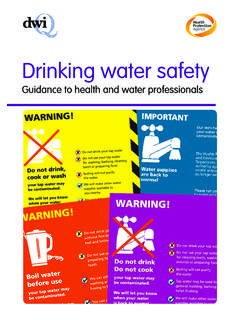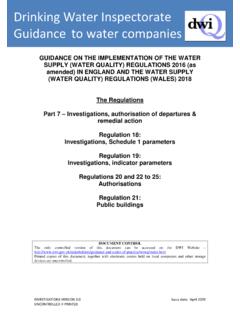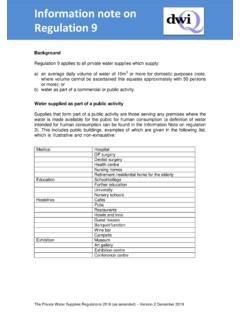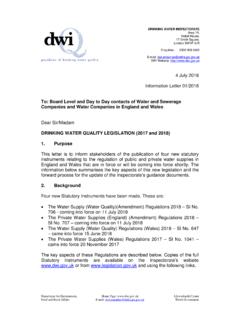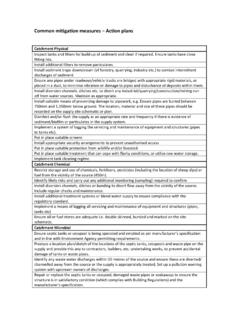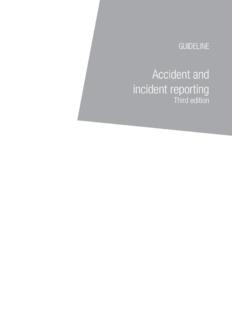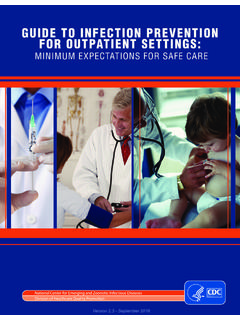Transcription of DWI GUIDANCE ON THE NOTIFCATION OF EVENTS
1 THE DRINKING WATER INSPECTORATE GUIDANCE ON THE NOTIFICATION OF EVENTS 2 Contents Section Page(s) DWI GUIDANCE on the notification of EVENTS 3 9 Annex 1: Paragraph 9 of the Water Industry (Suppliers Information) Direction 2009 10 11 Annex 2: Examples of EVENTS to be notified 12 13 Annex 3: Proforma for the notification of positive Cryptosporidium results from treated water samples 14 15 Annex 4: Information that should be included in the initial notification 16 17 Annex 5: Information that should be included in the interim report to be submitted within 3 working days of the notification 18 Annex 6: Information that should be included in the final report to be submitted within 20 working days of the notification 19 20 Annex 7: Event notification and assessment process 21 Document control 22 DWI GUIDANCE on event notifications Last updated 10th August 2009 V3 3 DWI GUIDANCE ON THE NOTIFICATION OF EVENTS 1 Introduction Water undertakers and water supply licensees are required to notify the Inspectorate of any event which, by its nature has, or is likely to adversely affect the quality or sufficiency of the water supplied by it, or, has or is likely to give rise to a significant risk to the health of the persons to whom the water is supplied.
2 This requirement is set out in paragraph 9(1) of the Water Industry (suppliers Information) Direction 2009 ( the Direction ), which came into effect on 8th April 2009. Similar requirements were set out in earlier Directions. Over the years the Inspectorate has provided water companies with GUIDANCE on event notification by way of Information Letters, the most recent being on 19th January 2009 (Information Letter 02/2009). This GUIDANCE updates and replaces the earlier GUIDANCE . 2 The Water Industry (Suppliers Information) Direction 2009 Paragraph 9 of the Direction provides generic GUIDANCE on the notification of EVENTS to the Inspectorate and the associated provision of information. It does not specify the type of EVENTS that should be notified. The requirements of the Direction are enforceable under section 18 of the Water Industry Act 1991 ( the Act ).
3 Paragraph 9 of the Direction is given in Annex 1 for reference. 3 Definitions In order to assist water undertakers and water supply licensees in their decision making processes, the Inspectorate has developed the following definitions: Event any occurrence, which by its nature is required to be notified under the Direction. It is not possible to provide an exhaustive list of situations that might be regarded as EVENTS . A list of examples, based on experience, can be found in Annex 2. The decision on whether or not to notify the Inspectorate has to rest with the water undertaker or water supply licensee, taking into account the particular set of local circumstances at the time. Notification is always prudent if a DWI GUIDANCE on notifications Last updated 10th August 2009 V3 4 situation has generated consumer concern, especially in respect of drinking water quality and health, but we expect companies to take a pragmatic view.
4 For example, in terms of event notification, there is no need to notify routine consumer contacts about water quality or compliance failures unless their character, singularly or collectively, would be considered unusual and thus amount to an event (see Annex 2 for examples). EVENTS will be classified into one of 5 categories depending on their potential to impact negatively on public confidence in the water supply. Those with a greater potential will potentially require a wider, or greater or different type of resource input to assess the Inspectorate may decide it appropriate to involve health professionals, press office, utilise GIS mapping capability within the organisation or simply escalate the resources available to investigate at an early stage. Additionally the information required from the company may vary significantly in terms of format, detail and timescales.
5 The event response framework provides an opportunity to maintain the current baseline standard for reporting whilst tailoring the reporting to DWI appropriately. It is recognised that occasionally the more serious EVENTS are those which take the longest time to investigate and conclude this framework provides the Inspectorate with suggested intermediate milestones for those EVENTS . 1. Not significant least potential negative impact on public confidence in the water supply 2. Minor some potential for negative impact on public confidence in the water supply, but not requiring significant level of investigation 3. Significant potential for negative impact on public confidence in the water supply requiring a detailed investigation and assessment of the event by a warranted Inspector. 4. Serious significant potential for negative impact on public confidence in the water supply requiring a detailed investigation and assessment of the event by a warranted Inspector, possibly with additional internal and external support (to be determined on initial assessment of the circumstances of the event).
6 5. Major - significant potential for negative impact on public confidence in the water supply requiring a detailed investigation and assessment of the event by a warranted Inspector with additional internal and external support at all seniority levels (to be determined on initial assessment of the circumstances of the event). The term significant is used frequently in the Direction and in the above definitions of an event. It is not possible to give a precise definition of its meaning in this context, as it will depend on each particular set of circumstances. Generally significant should be taken to mean higher than normal levels of contacts from consumers expressing concern. However it should be borne in mind that a serious DWI GUIDANCE on notifications Last updated 10th August 2009 V3 5 problem with a water supply may come to light through a report by just a single consumer.
7 The terms unexpected and unusual are also used and should be likewise interpreted sensibly. Paragraph 9(1)(a) makes specific reference to significant risk to the health of persons to whom the water is supplied . Companies therefore need to take account of more than just physical health, for example, a situation that is protracted causing anxiety to those affected directly or indirectly through publicity. It is always better to notify the Inspectorate of a perceived problem with drinking water quality, rather than the Inspectorate being made aware via a third party. This also applies to local or national media interest in drinking water issues that could result in consumer concern. No further action is required if the situation does not develop, other than to inform the Inspectorate of the outcome. Companies should be aware that anyone, not just themselves, can notify the Inspectorate of a situation involving actual or perceived risk to water quality.
8 The Inspectorate does not treat such notifications differently from those made by companies. DWI GUIDANCE on event notifications Last updated 10th August 2009 V3 6 4 The Notification Process The notification and reporting requirements are set out in paragraphs 9(2) to (4) of the Direction (see Annex 1). The company should contact the Inspectorate as soon as it is aware of a notifiable problem or of a developing situation, which might become notifiable. This should be done by telephone to the relevant Company Inspector specified within the cascade system. (IL 1/2009). In the case of positive Cryptosporidium results which satisfy criteria for notification, email may be used. For others, a follow up email should be sent in order to satisfy the requirements of the Direction. These should be sent to the EVENTS Team e-mail box specified in A pragmatic approach needs to be taken for situations that arise out of normal office hours.
9 Notification of minor EVENTS can probably wait until the next working day, unless they escalate in the meantime. All significant EVENTS should be notified by telephone using the cascade system and all notifications should be followed up by e-mail as specified in , in the case of out of hours notifications on the next working day. In the case of notifications of positive Cryptosporidium results in treated water samples, the proforma in Annex 3 should be used as the basis of the notification which in this case may be by email only. A list of the minimum information that should be supplied with the initial notification is given in Annex 4. This can be given over the telephone, with a follow up email. However it is recognised that some of this information may not be readily available at the time of the initial contact. Every effort should be made to include as much information as possible in the interim report, which has to be submitted to the Inspectorate within three working days of the initial notification (See Annex 5).
10 Updates should be provided during the intervening period if the situation escalates. The interim report should always be sent to the EVENTS Team preferably electronically and should use the following e-mail address: (DWI EVENTS ). This is to ensure that the company can be advised of the event classification within the required time period. (Company day-to-day contacts will be notified when this e-mail becomes active to permit current work to pass through and therefore companies should mail the notified Inspector until then). 5 Actions taken by the Inspectorate On receipt of the initial notification, the Inspectorate circulates outline details of the event to policy colleagues in Defra, the Welsh Assembly Government, and to key external stakeholders ( the Food Standards Agency, the Environment Agency DWI GUIDANCE on notifications Last updated 10th August 2009 V3 7 and Department of Health), as appropriate.


